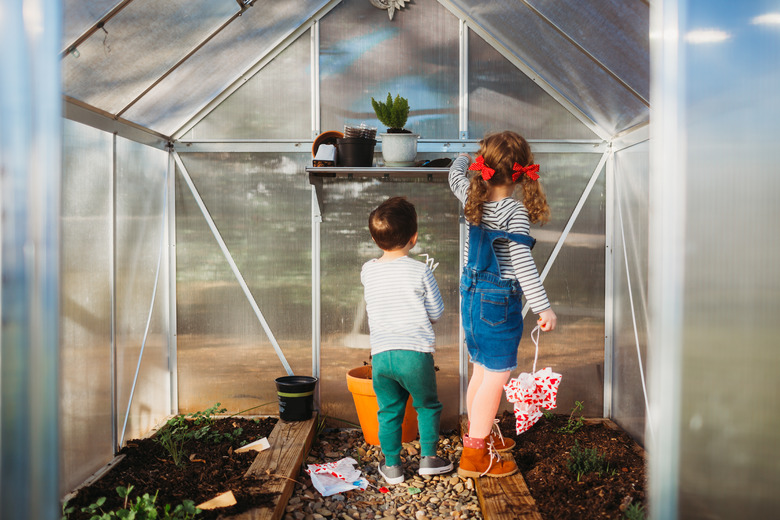How To Make A Greenhouse For A Science Project
This simple science experiment, adapted from the book "Teaching the Fun of Science" can demonstrate how a greenhouse works and how the atmosphere of the earth (as demonstrated by the plastic wrap) insulates and traps heated air. Students will learn how greenhouses retain heat, and why botanists and other plant growers use greenhouses in colder climates.
Step 1
Create a temperature data chart which will help explain the differences between the temperature inside and outside a greenhouse. The chart should include two rows labeled "Covered Box" and "Uncovered Box." Columns should be labeled "At Start" and then in 15 minutes increments, for at least one hour, or for as many times as you want to check the temperature. Keep in mind that depending on the time and temperature of the day, the temperature inside the greenhouse may continue to increase or may level off.
Step 2
Add two inches of soil to the inside of the two shoe boxes; use the ruler for accurate measurements.
Step 3
Cover one of the boxes with the clear plastic wrap; you may have to secure it with tape if it does not stretch or stay put easily. Leave the other box open and exposed to the air.
Step 4
Record the temperatures of two shoe boxes, and enter the information into the temperature data chart.
Step 5
Place the shoe boxes next to each other outside in the sunlight or on the ledge of a window sill that receives direct sunlight.
Step 6
Record the temperatures from both thermometers every 15 minutes for one hour, or until your desired length of time.
Things Needed
- Temperature data chart
- Two shoe boxes
- Ruler
- Soil
- Two thermometers
- Clear plastic wrap
- Tape
- Timer
- Pencil
- Sunny day
TL;DR (Too Long; Didn't Read)
For a more extensive project, experiment with more shoe box greenhouses that have varied surface materials. Prepare boxes with different surfaces materials, such as rock or sand; consider using different colors or surfaces as well such as white sand or black rocks. Also consider varying the amount of water in the soil, adding ice cubes to the shoeboxes, or adding a small dish with water to act as a pond.
Warning
While this is a relatively safe experiment, care should be taken when handling the thermometers as they might become overly hot from exposure to the heat of the sun.
Remember that any variations of the original science project should be performed at the same time, or under the same conditions, such as time and temperature, as your standard shoe box in order to keep the conditions as scientific as possible.
References
- Teaching the Fun of Science; Janice VanCleave; 2001.
- Greenhouse Effect
Cite This Article
MLA
Lauren, Daniella. "How To Make A Greenhouse For A Science Project" sciencing.com, https://www.sciencing.com/make-greenhouse-science-project-5553120/. 22 November 2019.
APA
Lauren, Daniella. (2019, November 22). How To Make A Greenhouse For A Science Project. sciencing.com. Retrieved from https://www.sciencing.com/make-greenhouse-science-project-5553120/
Chicago
Lauren, Daniella. How To Make A Greenhouse For A Science Project last modified August 30, 2022. https://www.sciencing.com/make-greenhouse-science-project-5553120/
